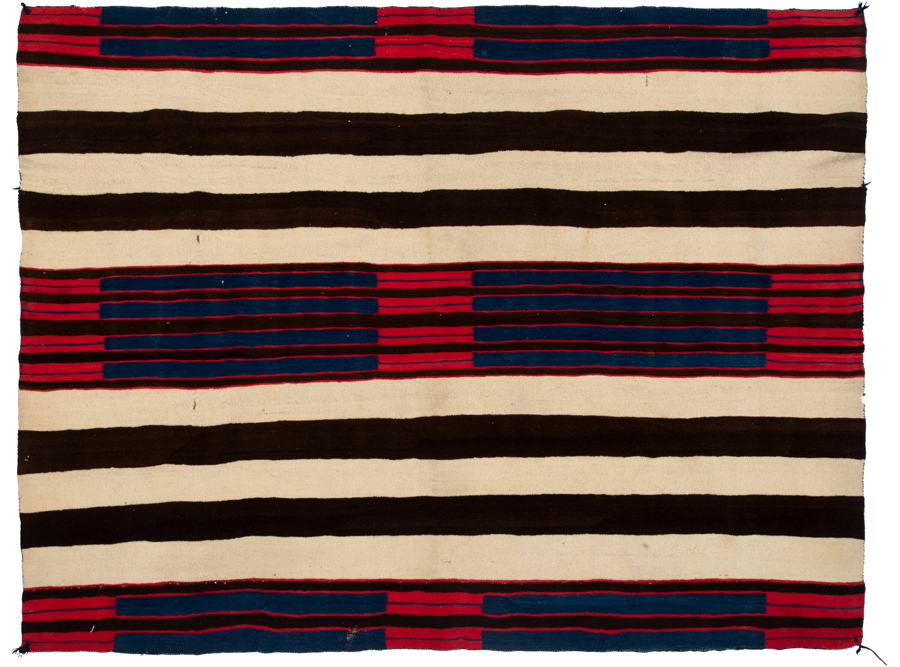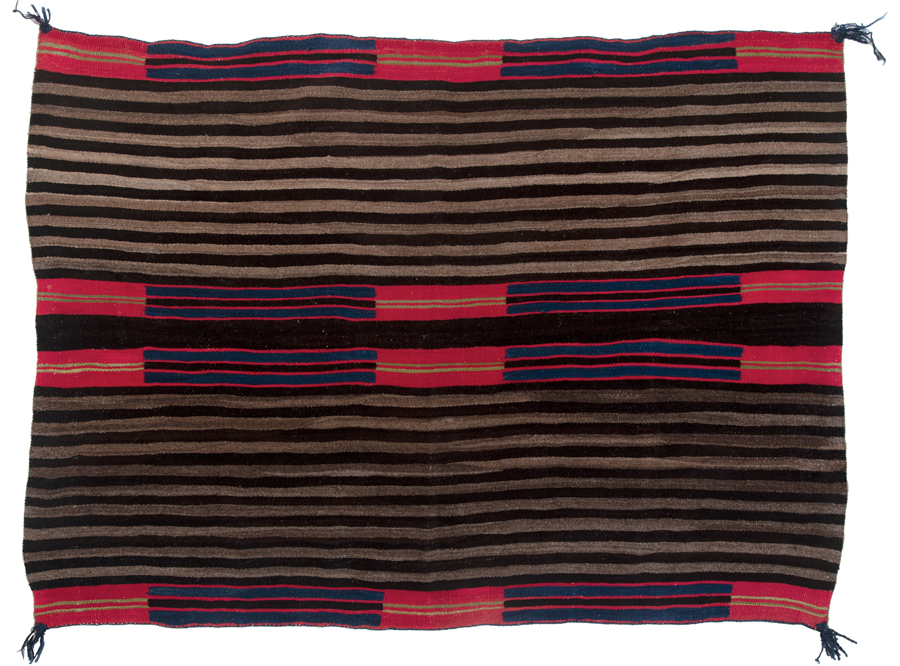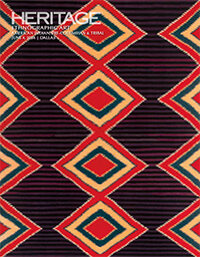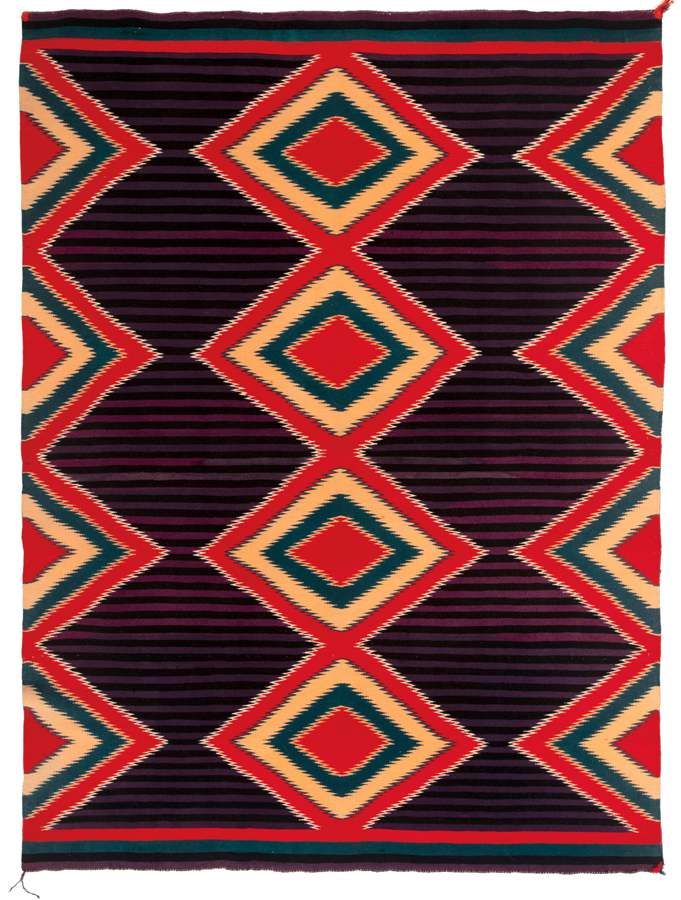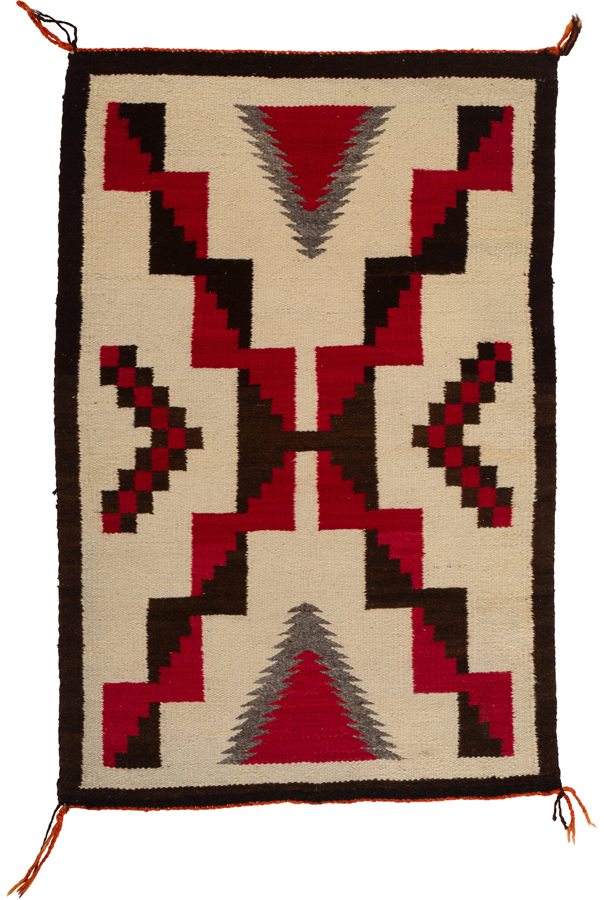AN IN-DEPTH LOOK AT THE RICH HISTORY WOVEN INTO A TRADITIONAL AMERICAN INDIAN TEXTILE REVERED FOR ITS CRAFTSMANSHIP AND DESIGN
By Christina Rees
Originally made to drape the shoulders of important members of the tribe, traditional Navajo wearing blankets have become sought-after collector’s items not only for their iconic designs and exquisite weaving but also for their historical significance. Examples such as the 19th-century Late Classic Navajo Man’s Wearing Blanket offered in Heritage’s June 4 Ethnographic Art auction represent one of the more desirable kinds of American Indian weavings and one of the most coveted by collectors. In conversation with Delia Sullivan, Heritage’s Director of Ethnographic Art, we dig into the context, history, design, and material realities of the blanket and its relationship to other types of Navajo blankets and rugs, some of which are also available in the auction.
The Late Classic Navajo Man’s Wearing Blanket, Second Phase Chief’s Pattern available in Heritage’s June 4 Ethnographic Art auction
Let’s start with the full name of this beautiful striped weaving: a Late Classic Navajo Man’s Wearing Blanket, Second Phase Chief’s Pattern. What does that mean?
In Navajo weaving, “Late Classic” refers to the period between 1865 and 1875, and “Man’s Wearing Blanket, Second Phase Chief’s Pattern” indicates the layout of the design. It’s oriented horizontally, so wider than it is long, with a pattern of broad bands of alternating ivory and brown – the natural colors of sheep – overlaid by a pattern of indigo-dyed stripes and red-dyed blocks at the nine “spots,” with three blocks in a column at center and three on either side, along the ends.
What is the difference between men’s and women’s blanket patterns?
Men’s blankets are composed of broad horizontal bands, while women’s blankets are composed of narrow bands. We have a terrific Woman’s Second Phase Wearing Blanket in this sale, by the way.
June 4, 2024
Online: HA.com/8165
INQUIRIES
Delia Sullivan
214.409.1343
DeliaS@HA.com
Dye tests are often used to gather pertinent information on weavings, including the Man’s Wearing Blanket available at Heritage. Tell us about the dye test done on this blanket.
You cannot tell, simply by sight, what kind of dye was used for red wool in these historic weavings. So, to determine whether a weaving is dyed with lac or cochineal – pre-synthetic dyes made from crushed insects – or aniline, made from coal-tar derivatives, which pretty much wiped out the cochineal market – you have to put it through a dye analysis. This entails snipping a tiny bit of the wool and sending it to a lab equipped with a spectrophotometer. Knowing the source of the red dye helps one date Navajo weavings, and those dyed with pre-synthetic, natural dyes are generally more valuable. The Man’s Wearing Blanket in question has been tested and is native handspun wool in indigo and natural dyes.
A Navajo Germantown Moki Serape, circa 1890
You mention wool. For the weavers, sources of wool changed over time. How and why did that happen? And can you tell us about Churro versus Merino wool and Germantown wool?
This involves knowing some history. In a strategic attempt to quell decades of fighting between the Navajo and the New Mexicans, the U.S. government forced the Navajo people out of Canyon de Chelly and moved them 400 miles eastward to an arid, isolated area of New Mexico called Bosque Redondo. While there, from 1863 to 1868, the Navajo lived meagerly, many died, and their flock of sheep was decimated; it went from 200,000 to less than 1,000.
Subsequently, as the cruelty and expense of this internment became apparent to U.S. government officials, the Navajo were allowed to return to their homeland west of the Chuska Mountains. The government gave the Navajo 15,000 sheep – Merino sheep. The Navajo original flock, introduced to them in the late 16th century by the Mexicans, were Churro sheep. Merino wool is short, kinky and greasy compared to the long, straight and greaseless wool of the Churro. The lesser quality of the Merino wool is one of the reasons the Navajo turned to commercial wool and raveled commercial garments; synthetic-dyed Germantown wool (named for its source, Germantown, Pennsylvania) became popular with Navajo weavers for its depth of colors.
This circa 1960 Large Navajo Regional Rug is an example of a storm pattern.
After the expansion of the railroads, how did the making and trading of these weavings shift?
Traditionally, the Navajo made weavings as garments for themselves. Then trading posts sprang up throughout New Mexico and Arizona, while the railroads brought scores of travelers from the East. The Navajo were now in the business of making rugs for tourists. The owners of the trading posts exerted great influence over the weavers. One trader, Juan Lorenzo Hubbell, supplied the weavers of the Ganado, Arizona, area with specific patterns and dyes. Ganado regional rugs are easily recognizable, with bold patterns woven of white, brown, gray and red wool. Another trader, John B. Moore, encouraged weavers to create weavings similar to Oriental rugs, spawning the fancy Teec Nos Pos and Two Grey Hills regional rugs. The popular design known as the “storm pattern” probably originated with Moore.
What else about time periods affects how we look at or classify weavings? What about the evolution of patterns?
Again, originally Navajo made weavings to wear. Their classic wearing blankets and mantas were simple. The design of a First Phase Chief’s Blanket consists of only horizontal bands with some indigo and red dye. Second Phase Chief’s Blankets, like the one we have in this auction, evolved to include red rectangles overlaying the bands. And with Third Phase Chief’s Blankets, diamonds and half diamonds replaced the rectangles.
Serapes have more flair, including zigzag bands, serrations and bisected diamonds. Transitional weavings – the transition between wearing blankets and rugs – can have many of the Late Classic design elements and have no border, like the earlier garments, but they’re heavier and made from later materials. Some were clearly made for the floor.
A spirit line graces the upper left corner of this circa 1930 Navajo Yei Rug.
Let’s walk through a few more specifics about what we see woven into these textiles. There are signature Navajo techniques and vernacular. I’ve heard you mention the spirit line, lazy lines and eye dazzlers.
In satisfying the traders and the tastes of the tourists, weavers created rugs with borders. A spirit line is one line of wool that traverses the border. It is intentionally incorporated as a path to free the spirit (so intertwined with the maker), to allow the spirit to get out. Despite the relatively new commercialism, Navajo weaving was still a spiritual endeavor – a prayer to Spider Woman, the deity who taught the weaver to weave.
There are a number of lazy lines in this Navajo Regional Rug.
A Navajo weaver works on one section of a weaving, the area right within her reach, and then she moves – physically – on to another section, creating perhaps another 12-inch square, thereby creating a small fissure where the two sections meet. This is called a lazy line, perhaps because the weaver does not move all the way across the width of the weaving with each line of weft. Navajo weavings are the only weavings in the world with lazy lines.
A Navajo Germantown Weaving, circa 1885
And eye dazzlers are designs of fine serrations, much like those in the Rio Grande/Saltillo serapes of Northern Mexico. When well executed, an eye dazzler can have the effect of an optical illusion.
What adds up to make the Man’s Wearing Blanket available at Heritage a highlight of the June 4 auction?
Its age, rarity and beauty. There are only a couple of hundred known to exist. The dye test for this weaving came back as cochineal. The simplicity of its design can be presented in both a traditional and a contemporary home design. Second Phase Man’s Wearing Blankets are easily commanding six figures in today’s market. There are new buyers for Navajo weavings, and collectors and institutions are seamlessly blending Classic and Late Classic weavings into collections of contemporary art.
 CHRISTINA REES is a staff writer at Intelligent Collector.
CHRISTINA REES is a staff writer at Intelligent Collector.


